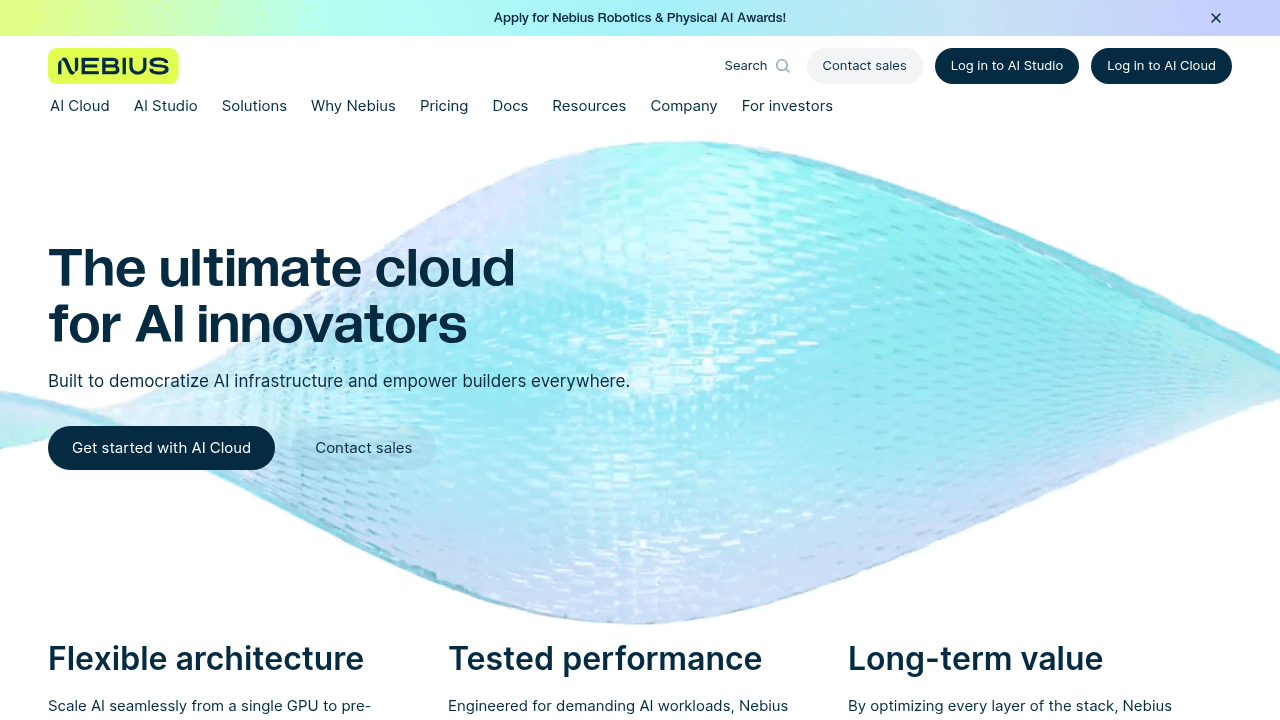Thunder Compute vs Nebius (December 2025)

Choosing between GPU cloud providers can feel overwhelming when you're trying to balance cost, performance, and ease of use. You've probably noticed that most options either break your budget with enterprise pricing or force you into complex setups that eat up development time. Fortunately, there's a clear winner when comparing providers like Nebius and newer alternatives. Let's break down how Thunder Compute's API delivers the same powerful H100 and A100 access at dramatically lower costs, with none of the enterprise complexity that slows down individual developers and small teams.
TLDR:
- Thunder Compute costs less than Nebius with H100s at $1.89/hour vs $2.00+/hour and no commitments
- You get one-click VS Code integration and instant deployment vs Nebius's complex Kubernetes setup
- Thunder Compute targets individual developers while Nebius requires enterprise budgets and DevOps teams
- Hardware swapping and environment snapshots work smoothly vs Nebius's separate storage/networking fees
- Thunder Compute offers affordable GPU cloud with developer-first features and transparent pricing
What Nebius Does and Its Approach

Nebius positions itself as a dedicated AI cloud provider, focusing on machine learning infrastructure instead of general-purpose computing. The company came from Yandex's cloud division and has built its entire business around serving AI workloads with enterprise-grade infrastructure.
Their approach focuses on high-end GPU clusters featuring cutting-edge hardware like H100s and L40S GPUs. Nebius features large-scale deployments with advanced networking features, including InfiniBand connections that allow fast inter-GPU communication across multiple nodes. This infrastructure design targets organizations running distributed training jobs that require hundreds or thousands of GPUs working together.
The company operates primarily out of European data centers, though they're expanding into US markets. Their business model revolves around longer-term commitments and reserved capacity instead of pure on-demand usage. While they offer some hourly pricing, their best rates come through committed use contracts that can span months or years.
Nebius markets itself to AI startups and enterprises that have moved beyond prototyping into production-scale model training. They provide managed services around their infrastructure, handling much of the cluster orchestration and maintenance that would otherwise require dedicated DevOps teams.
Their target customers typically have substantial AI budgets and technical teams capable of managing complex distributed workloads. This positions them as an alternative to hyper-scalers like AWS for companies that want AI-specialized infrastructure without the complexity of general cloud services.
What Thunder Compute Does and Our Approach

Thunder Compute takes a fundamentally different approach from enterprise-focused providers like Nebius. We're built for individual developers, researchers, and small teams who need powerful GPU computing without the complexity or cost of traditional cloud services.
Our core mission is making GPU access affordable and frictionless. While others target large organizations with massive budgets, we focus on democratizing AI development for everyone else. This means substantially lower costs than major cloud providers and a setup process that takes seconds, not hours.
Thunder Compute provides on-demand GPU instances with 1-4 GPUs per machine, featuring everything from T4s to H100s. The key difference is in a software-driven approach that maximizes hardware performance, which allows savings to pass directly to users.
Unlike providers focused on distributed training across hundreds of GPUs, Thunder Compute optimizes for the common case: developers who need reliable, affordable GPU access for model fine-tuning, experimentation, and smaller-scale training jobs. This includes unique features like taking snapshots of your entire environment and resuming work exactly where you left off.
Pricing Comparison
The pricing difference between Nebius and Thunder Compute reveals two completely different philosophies around GPU cloud access. Nebius operates on an enterprise model with premium rates and optional commitment requirements, while Thunder Compute focuses on affordable, transparent pricing for individual developers.
Nebius charges around $2.00 per hour for H100 access, but their best rates require substantial upfront commitments and minimum monthly spending. They also charge separately for storage, networking, and support services, making the true cost much higher than advertised hourly rates.
Thunder Compute takes the opposite approach. Our A100-80GB instances cost $0.78/hour with no commitments required. H100s are available at $1.89/hour, representing massive savings compared to Nebius's enterprise pricing model.
| Provider | H100/hour | A100-80B/hour | Minimum Commitment |
|---|---|---|---|
| Nebius | $2.00 | $1.80+ | Monthly minimums |
| Thunder Compute | $1.89 | $0.79 | None |
Thunder Compute includes persistent storage, VS Code integration, and all core features at no additional cost, while Nebius charges separately for these essentials.
The commitment difference matters enormously for smaller teams. Nebius requires negotiating contracts and meeting minimum spending thresholds to access their best rates. Thunder Compute offers transparent pay-as-you-go pricing from day one.
Developer Experience and Integration

The developer experience gap between Nebius and Thunder Compute reflects their fundamentally different target audiences. Nebius requires deep technical expertise to work through their enterprise-focused infrastructure, while Thunder Compute is focused around developer productivity.
Nebius operates through Kubernetes orchestration and container-based deployments. Setting up a development environment involves configuring YAML files, managing container registries, and understanding their cluster management system. This enterprise approach assumes you have DevOps expertise or dedicated infrastructure teams to handle the complexity.
Thunder Compute eliminates this friction entirely. Our VS Code extension lets you launch and connect to GPU instances with a single click. No SSH keys, no CUDA installations, no container orchestration. You're coding on a remote GPU machine within seconds, exactly as if it were running locally. Thunder Compute's hardware swapping feature even lets you change GPU types mid-project without losing your development environment or data.
The workflow differences become stark when comparing day-to-day usage. Nebius requires managing persistent volumes separately, configuring networking between services, and dealing with enterprise GPU complexity that most individual developers never need. Thunder Compute provides features designed for iterative development: snapshots that save your entire environment state, persistent storage that survives instance restarts, and the ability to pause instances when not in use. These features simply don't exist in Nebius's enterprise-focused model.
Target Audience and Use Cases
The target audiences for Nebius and Thunder Compute couldn't be more different, reflecting their distinct approaches to GPU cloud computing. Understanding these differences helps clarify which service fits your specific needs and budget.
Nebius primarily serves enterprise customers with substantial AI budgets and dedicated infrastructure teams. Their typical clients include large AI labs training foundation models, Fortune 500 companies implementing AI at scale, and well-funded startups that need guaranteed GPU availability for production workloads. These organizations often require multi-node clusters with hundreds of GPUs for distributed training jobs that can run for weeks or months.
Thunder Compute targets the vast majority of AI practitioners who don't need enterprise-scale infrastructure. Our users include individual ML engineers fine-tuning models, academic researchers with limited budgets, AI consultants working on client projects, and early-stage startups looking into AI applications. These developers typically need 1-4 GPUs for experimentation, prototyping, and smaller training jobs.
Why Thunder Compute is the Better Choice
For the vast majority of AI developers, Thunder Compute delivers superior value compared to Nebius's enterprise-focused approach. The choice comes down to whether you need accessible, affordable GPU computing or complex enterprise infrastructure with premium pricing.
The cost difference and savings are obviously clear. Plus Thunder Compute operates on pure pay-as-you-go pricing meaning you can spin up an H100 for a few hours of experimentation without negotiating contracts or meeting spending thresholds.
The Thunder Compute integrated development experience provides features that Nebius simply doesn't offer. Features like hardware swapping, environment snapshots, and VS Code integration are designed for iterative AI development and natively supported (versus being bolted on).
The reality is that most AI development doesn't require enterprise-scale infrastructure. Whether you're fine-tuning models, running inference experiments, or prototyping new applications, Thunder Compute provides everything a developer needs without the overhead of enterprise complexity.
Wrap-up: Thunder Compute or Nebius?
The comparison between Thunder Compute and Nebius shows two fundamentally different approaches to GPU cloud computing. Nebius serves enterprise customers who need massive clusters and don't mind paying premium rates for complex infrastructure. Thunder Compute focuses on making powerful GPU access affordable and accessible for everyone else.
For most AI practitioners, the choice is clear. Thunder Compute delivers the same cutting-edge hardware at dramatically lower costs and the developer-first approach eliminates the complexity that makes enterprise providers impractical for individual developers and small teams. While Nebius assumes you have dedicated DevOps teams and enterprise budgets, we've built everything around the reality of how most AI development actually happens. Thunder Compute's integrated VS Code experience, hardware swapping features, and instant deployment tools represent a completely different philosophy about how GPU computing should work.
Whether you're fine-tuning models, running experiments, or building AI applications, you shouldn't need enterprise contracts or infrastructure expertise to access powerful GPUs. Thunder Compute proves that world-class AI development can be both affordable and straightforward.
FAQ
How much can I save by choosing Thunder Compute over Nebius?
You'll save on GPU costs with Thunder Compute's H100s at $1.89/hour compared to Nebius's $2.00 rates, plus you avoid their monthly commitment requirements and separate charges for storage and networking.
What's the main difference between Thunder Compute and Nebius's setup process?
Thunder Compute offers one-click deployment through VS Code with no SSH setup or CUDA installations required, while Nebius requires Kubernetes expertise, YAML configuration, and container orchestration to get started.
Can I use Thunder Compute without long-term commitments like Nebius requires?
Yes, Thunder Compute operates on pure pay-as-you-go pricing with no minimum spending thresholds or monthly commitments, unlike Nebius which pushes enterprise contracts for their best rates.
When should I choose Thunder Compute over an enterprise provider like Nebius?
Choose Thunder Compute if you're an individual developer, researcher, or small team needing 1-4 GPUs for model fine-tuning, experimentation, or smaller training jobs instead of massive distributed workloads requiring hundreds of GPUs.
How does Thunder Compute's hardware swapping feature work compared to Nebius?
Thunder Compute lets you change GPU types mid-project without losing your development environment or data, while Nebius requires setting up entirely new cluster configurations and managing persistent volumes separately.
Final Thoughts on Choosing Between Thunder Compute and Nebius for GPU Cloud Computing
Most developers don't need enterprise complexity to build great AI applications. The math here is simple: you get the same powerful GPUs for less with Thunder Compute, plus an experience built for how you actually work. While Nebius targets enterprises with deep pockets and dedicated teams, we focus on making GPU computing accessible to everyone else. Your next breakthrough shouldn't wait for enterprise budgets or complex infrastructure.